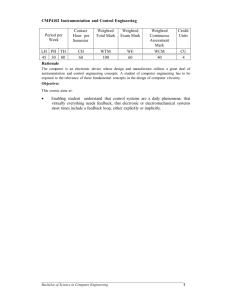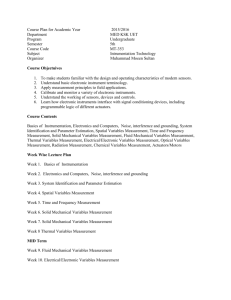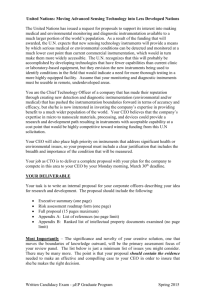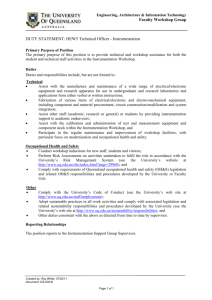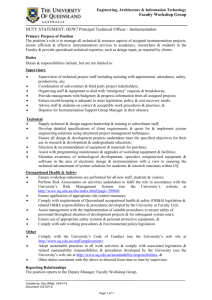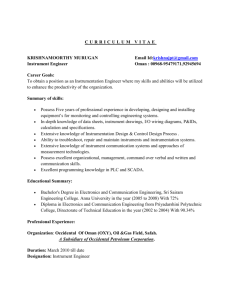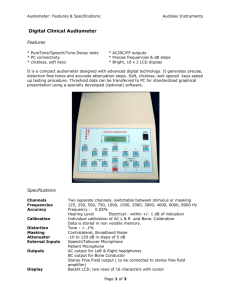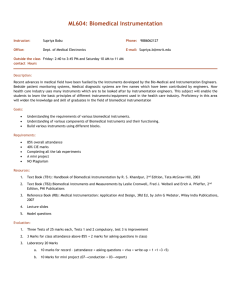BIOMEDICAL INSTRUMENTATION
advertisement
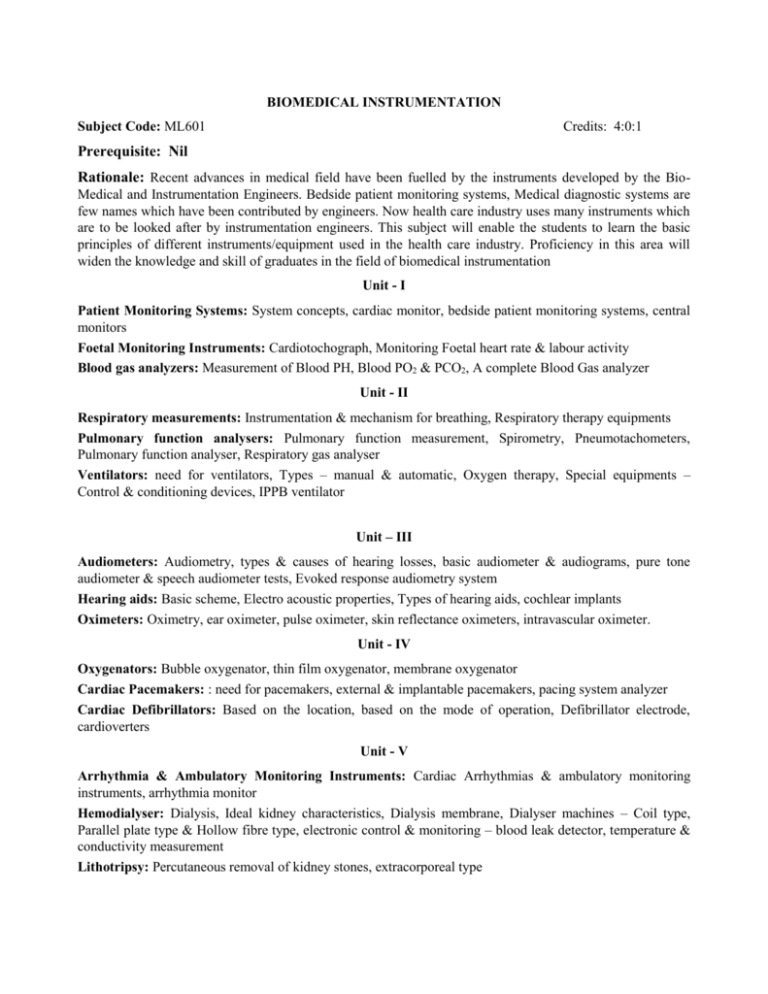
BIOMEDICAL INSTRUMENTATION Subject Code: ML601 Credits: 4:0:1 Prerequisite: Nil Rationale: Recent advances in medical field have been fuelled by the instruments developed by the BioMedical and Instrumentation Engineers. Bedside patient monitoring systems, Medical diagnostic systems are few names which have been contributed by engineers. Now health care industry uses many instruments which are to be looked after by instrumentation engineers. This subject will enable the students to learn the basic principles of different instruments/equipment used in the health care industry. Proficiency in this area will widen the knowledge and skill of graduates in the field of biomedical instrumentation Unit - I Patient Monitoring Systems: System concepts, cardiac monitor, bedside patient monitoring systems, central monitors Foetal Monitoring Instruments: Cardiotochograph, Monitoring Foetal heart rate & labour activity Blood gas analyzers: Measurement of Blood PH, Blood PO2 & PCO2, A complete Blood Gas analyzer Unit - II Respiratory measurements: Instrumentation & mechanism for breathing, Respiratory therapy equipments Pulmonary function analysers: Pulmonary function measurement, Spirometry, Pneumotachometers, Pulmonary function analyser, Respiratory gas analyser Ventilators: need for ventilators, Types – manual & automatic, Oxygen therapy, Special equipments – Control & conditioning devices, IPPB ventilator Unit – III Audiometers: Audiometry, types & causes of hearing losses, basic audiometer & audiograms, pure tone audiometer & speech audiometer tests, Evoked response audiometry system Hearing aids: Basic scheme, Electro acoustic properties, Types of hearing aids, cochlear implants Oximeters: Oximetry, ear oximeter, pulse oximeter, skin reflectance oximeters, intravascular oximeter. Unit - IV Oxygenators: Bubble oxygenator, thin film oxygenator, membrane oxygenator Cardiac Pacemakers: : need for pacemakers, external & implantable pacemakers, pacing system analyzer Cardiac Defibrillators: Based on the location, based on the mode of operation, Defibrillator electrode, cardioverters Unit - V Arrhythmia & Ambulatory Monitoring Instruments: Cardiac Arrhythmias & ambulatory monitoring instruments, arrhythmia monitor Hemodialyser: Dialysis, Ideal kidney characteristics, Dialysis membrane, Dialyser machines – Coil type, Parallel plate type & Hollow fibre type, electronic control & monitoring – blood leak detector, temperature & conductivity measurement Lithotripsy: Percutaneous removal of kidney stones, extracorporeal type LABORATORY 1. 2. 3. 4. 5. 6. 7. 8. Determination of Respiratory Rate using Temperature Transducer Pulse Rate using Photo Transducer Determination of Hearing Loss by Air conduction & bone Conduction tests using Audiometer Demonstration & Study of: a. Respiratory rate using Temperature Transducer b. Pulse Rate using Photo Transducer Output Characteristics of recorded Bio Signal using: X-Y Recorder/ X-t Recorder Principle & Working of Ultrasound Scanner Demonstration of interfacing the following equipment: a. Oximeter b. Spirometer c. Ventilator d. Haemodialysis Machine e. Physiotherapy Equipment f. Electrotherapy Equipment Determination of percentage Transmittance, Absorbance & Concentration of given solutions using Spectrophotometer Text Book(s): 1. Handbook of Biomedical Instrumentation – by R. S. Khandpur, 2nd Edition, Tata McGraw Hill, 2003 Reference(s): 1. Bioinstrumentation , John G Webster, Wiley India Publications, 2007


